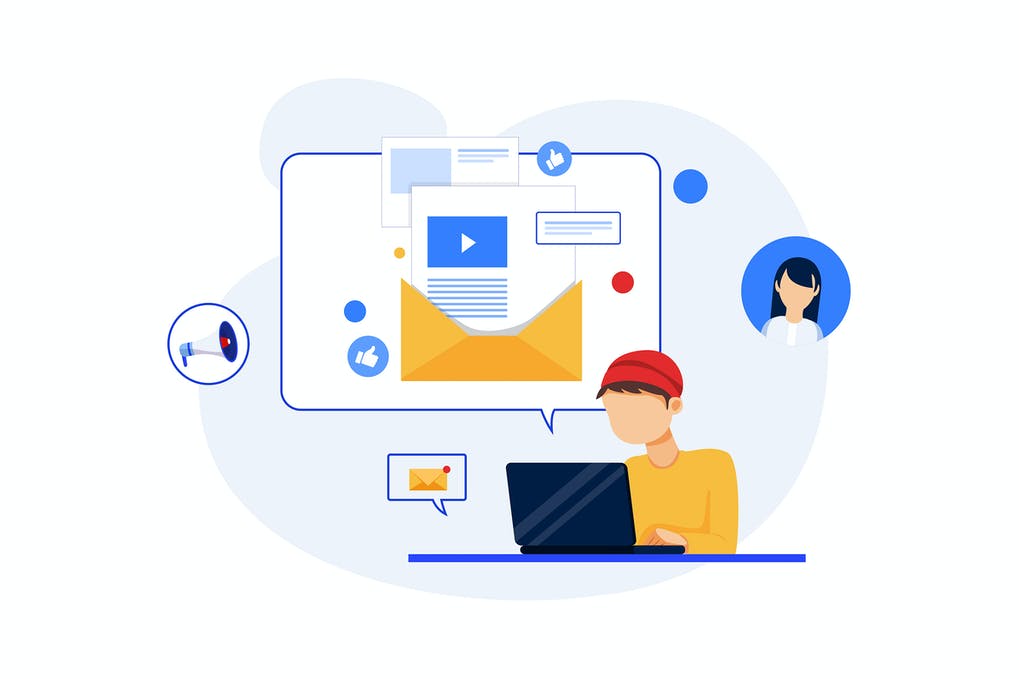Inbound Marketing VS Outbound Marketing in Switching your Strategy
Each day, the average person is exposed to between 6,000 and 10,000 advertisements – about quadruple the quantity in 2007.
Yes, this encompasses everything from television advertisements and outdoor signage to radio commercials and digital advertisements on the internet and social media. That's a LOT of competition for the attention of your prospects. It's enough to make B2B marketers wonder, "How am I ever going to reach the individuals I need to speak with?" and "What am I ever going to say to convince them to buy?"
Today, marketers utilize one of two unique tactics to connect with prospects: inbound marketing or outbound (or "conventional") marketing. Consider the critical distinctions between the two.
Inbound Marketing vs. Outbound Marketing
Outbound marketing is a one-way blitz strategy to marketing that focuses on the product or solution rather than the client, whereas inbound marketing is customer-driven and draws prospects by helping them find solutions to their problems in a more personalized manner.
Outbound Marketing |
Inbound Marketing |
|---|---|
| Marketing centric approach | Customer-centric approach |
| You push your message out to the masses, hoping that somebody will respond. | You attract prospects through valuable content. |
| Marketer interrupts the customer | Marketer gets permission from the customer |
| Outbound Marketing is more expensive. | Inbound Marketing is less expensive. |
| Produces Quick results | Results take time |
| Channels include: Email Spam, Cold Calling, Media Buys | Channels include: SEO, PPC, Content Marketing, Personalized Emails |
What Is Outbound Marketing?
Marketers have been using outbound marketing since there have been items and services to sell. Outbound marketing is often referred to as interruption or push marketing these days since it uses a single message to reach a large audience in the hopes that someone, anyone, finds the message compelling and becomes a customer.
Despite the fact that just 18% of marketers believe that outbound methods produce the highest-quality leads for sales, the following tactics are still extensively used today:
- Email blasts
- Trade fairs
- Billboards
- Door-to-door distribution of fliers
- Commercials on television and radio
- Telemarketing calls
Unfortunately, identifying the best qualified leads is nearly impossible with these methods because you're looking for one possibility among thousands. Furthermore, outbound approaches can be costly in the long run, the ROI is difficult to calculate, and almost everyone considers these methods unhelpful and just plain bothersome (some estimates suggest the average Joe sees as many as 10,000 ads every day).
What Is Inbound Marketing?
Inbound marketing aims to meet customers right where they are in the Buyer's Journey. Whether a prospect is at the awareness, contemplation, or decision stage of their purchasing path, inbound marketing attempts to supply them with the relevant material at the right time to assist them in solving their problems.
Some of the well-known and beloved incoming approaches are:
- Blog content
- Webinars
- Infographics
- E-books and Whitepapers
- Checklists
- Success Stories
- Comparisons
- Paid Ads
Inbound marketing, as opposed to outbound marketing, is driven by buyer personas, which are semi-fictional representations of your ideal customers based on real data from real customers. When you dig into your buyer personas, you discover about your customers' concerns, demographic information, and more, which allows you to design targeted campaigns and content to help them go through the Buyer's Journey.
Furthermore, Inbound marketing is a more long-term strategy than outbound marketing. You can spend a lot of money on commercials and billboards and see a lot of people walk through the door, but there's a good chance those leads won't be qualified. In the end, the customer acquisition cost for outbound marketing leads is substantially greater than the customer acquisition costs for inbound marketing leads.
Advantages of Inbound Marketing
Inbound Marketing offers several advantages over Outbound Marketing. These include:
- Inbound is more effective.
- Inbound offers higher ROI.
- Inbound is highly cost-effective in comparison with Outbound.
- Inbound offers valuable content to solve customer's problems.
- Inbound offers experiences tailored to meet customer's needs and journey.
Transitioning from Outbound to Inbound Marketing
According to HubSpot, 75% of inbound firms believe their marketing strategy is effective, while 30% say outbound marketing tactics are overvalued. However, it is not simple to avoid outbound strategy and switch to inbound strategy, and reaping the benefits.
Before switching to Inbound program, it is essential to put a clear strategy that will help you make informed decisions about your foray into the Inbound Marketing space and ensure that you are focused on the right Inbound marketing elements relevant to your business. You may require a hybrid approach, a mix of inbound and outbound approach, in the short-term to tick all of the boxes for your clients, or you may be able to secure the best qualified leads with an all inbound marketing strategy.
To establish which method is best for your company, examine your buyer profiles, as well as your sales and marketing objectives. It is an important step towards creating business relationships with your customers and prospects and growing your revenue.
Reasons to combine Outbound and Inbound Marketing:
In seven years of our experience in Outbound and Inbound Marketing, here are the reasons why we suggest combining both the marketing approaches in the short-term:
- Buyers may not know about your solutions and brand, and you need to push your message out.
- Inbound Marketing takes time to produce results, and companies may not always rely on it for generating leads for events, webinars or tradeshows.
- Outbound Marketing is costly for maintaining long-lasting relationships with customers and building a positive brand reputation.
- Small and medium companies may not have enough content optimized for search engines and for attracting customers.
See: 4 Successful ways to combine Inbound and Outbound Marketing
These are some of the important reasons why you may need to employ a hybrid approach in the short-term. Once your content and inbound activities started showing good results, you may put more focus on Inbound marketing activities for promoting your brand and solutions.
Take a Look at What Inbound Marketing Can Do
Are you ready to discover how inbound marketing may help your overall marketing strategy? Take our Marketing Assessment to find out how your marketing stacks up and to receive actionable advice for enhancing your company's marketing approach.

